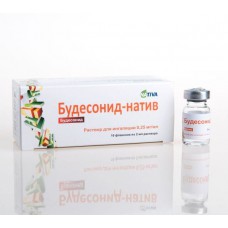Expiration date: 04/2026
Release form
Solution for inhalation.
Composition
Active substance: budesonide 0.25 mg/ml.
Excipients: methyl parahydroxybenzoate (nipagin) - 0.5 mg, succinic acid - 1.5 mg, disodium edetate (Trilon B) 0.5 mg of macrogol 400 (polyethylene oxide-400) - 350 mg propylene glycol, 200 mg, purified water to 1 ml.
Packaging
10 vials of 2 ml.
10 PCs
Pharmacological action
A synthetic glucocorticosteroid (GCS) for local application, anti-inflammatory, antiallergic and immunosuppressive effect. It increases production of lipomodulin, which is an inhibitor of phospholipase A, inhibits the release of arachidonic acid, inhibits the synthesis of products of meta-bolism arahidonova acid - cyclical endoperekisey, and prostaglandins (Pg). Warns boundary accumulation of neutrophils, reduces inflammatory exudation and production of cytokines, inhibits the migration of macrophages, reduces in-tensively processes of infiltration, the formation of chemotactic substances, inhibits the release of fat cells mediators of inflammation.
Increases the number of "active" beta-adrenergic receptors and restores the bronchial response to bronchodilators, allowing to reduce the frequency of their use, reduces swelling of mucous membrane bronchi, production of mucus, the formation of phlegm and reduces Hyper-reactivity of the Airways. Improves mucociliary transport. Well tolerated in long-term care, has mineralocorticosteroid activity, in recommended doses it practically has no systemic effect.
The therapeutic effect starts a few hours after inhalation. The maximum therapeutic effect develops in a few days after administration of therapeutic doses of inhaled budesonide, on average, 5-7 days.
Inhalation of budesonide can prevent the attack of asthma, but not relief of acute bronchospasm.
Testimony
Bronchial asthma (BA) requiring maintenance therapy of corticosteroids, chronic obstructive pulmonary disease (COPD).
Contraindications
Hypersensitivity to the drug, child age to 16 years.
Application of pregnancy and breastfeeding
During pregnancy and lactation should be careful. The purpose of the drug is rational if the benefits of its use to the mother outweighs the potential risk to the fetus or child.
Data on the allocation of budesonide in breast milk are missing.
Method of application and doses
The dosage of the drug "Budesonide-Nativ" must be individual. Initial dose in adults for the treatment of asthma and COPD is 1 - 2 mg per day. Dose for maintenance treatment is 0.5 - 4 mg a day. After getting the effect of reduce the dose to the minimum effective dose required to maintain stable state. In some cases, patients, the treatment of which requires the achievement of fast therapeutic effect the dose can be increased.
If the patient was taking oral corticosteroids, the translation of the treatment Budesonida-Nativ should be carried out under stable condition of the patient for 10 to 14 days to combine inhalation and receiving GKS inside. Within 10 days advised to take high doses of Budesonide-Nativ in patients receiving oral corticosteroids in a selected dose. In the future the dose of oral corticosteroids should be gradually reduced (e.g., 2.5 mg of prednisone or cortisone) to the lowest possible level. In many cases it is possible to completely abandon the use of oral corticosteroids. Data on the use of budesonide in patients with renal insufficiency or impaired liver function no. Since the excretion of budesonide is due to biotransformation in the liver, one can expect an increase in the duration of action of the drug in patients with severe liver cirrhosis.
Children 16 years and older: initial dose 0.25-0.5 mg/day. If necessary, the dose may be increased to 1 mg/day. The maintenance dose is 0.25-2 mg/day.
The appointment of patients with liver cirrhosis requires a more thorough observation.
The drug is administered with a nebulizer. The bottle contains 1 dose.
Side effects
Often (>,, 1/100): cough, dry mouth, hoarseness, dysphonia, irritation of the mucous membrane of the mouth and throat, oral thrush, dryness of the mucous membrane of the pharynx, headache, nausea.
Rarely (<,, 1="" 1000="" :="" -="" 2-="" br="">,High doses of the drug can lead to the development of systemic side effects exhaustion of the adrenal cortex, hyperglycemia, hypertension.
Special instructions
Budesonide-Nativ is not intended for relief of acute asthma symptoms and COPD. Should strictly observe the instructions for use of inhaler. Avoid getting product in eyes. After treatment it is recommended to rinse your mouth with water to reduce the risk of thrush.
When transitioning from therapy with oral corticosteroids to the drug "Budesonide-Nativ" reduction in the dosage of systemic corticosteroids should be implemented very slowly and in small doses (e.g. 2.5 mg prednisolone). Patients who were on prolonged therapy with systemic corticosteroids, the possible syndrome of pseudorheumatism. In these cases it is sometimes necessary to temporarily increase the dose of oral corticosteroids. In rare cases, symptoms such as fatigue, headaches, nausea, vomiting. After the complete abolition recommended for long-time monitoring of the patient (risk of adrenal insufficiency), as well as the assessment of respiratory function. Drug "Budesonide-Nativ", can be administered to patients who cannot use other forms of inhaled corticosteroids (patients of elderly and senile age).
The drug does not affect the ability to activities potentially hazardous activities that require special attention and fast reactions (driving and other vehicles, work with moving machinery, work Manager and operator, etc.).
Only use in nebulizers.
Drug interactions
In the treatment of bronchial asthma Budesonide-Nativ goes well with beta2-agonists, kromoglitsievoy acid or nedocromil, methylxanthines and the ipratropium bromide. Phenobarbital, phenytoin, rifampicin reduces the efficacy (induction of microsomal liver enzymes). Methandienone, estrogens increase the concentration of budesonide in plasma. Administration of 200 mg of ketoconazole 1 time per day increases the plasma concentration of budesonide taken orally in the dose of 3 mg an average of 6 times. In the appointment of ketoconazole in 12 h after administration of budesonide plasma concentration of the last increases in 3 times. Information about such interaction with inhaled dosage forms of budesonide is missing, however, one should expect a marked increase in the drug concentration in the plasma.
Other potential inhibitors of CYP3A4, such as Itraconazole, also significantly increases the plasma concentration of budesonide. The drug can be diluted with 0.9% sodium chloride solution.
Overdose
In acute overdose, clinical manifestations does not occur. Prolonged use of the drug in doses, greatly exceeding recommended, may develop systemic glucocorticosteroid effect of hypercortisolism and suppression of adrenal function.
Storage conditions
Dry dark, inaccessible to children at temperature not exceeding 25°C.



